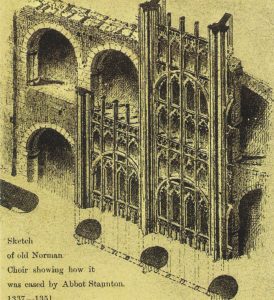 Gloucester Cathedral in England in 1392 was a monastic church and played an important role in Memento Mori, the third novel in my Lady Apollonia West Country Mysteries. It was the Abbey of Saint Peter in the 14th century and was the most important monastic house in Gloucester. My last posting discussed the Norman architecture of the cathedral. I would now like to focus on the Gothic architecture of the church.
Gloucester Cathedral in England in 1392 was a monastic church and played an important role in Memento Mori, the third novel in my Lady Apollonia West Country Mysteries. It was the Abbey of Saint Peter in the 14th century and was the most important monastic house in Gloucester. My last posting discussed the Norman architecture of the cathedral. I would now like to focus on the Gothic architecture of the church.
Some parts of the church, especially in the transepts and the quire have the newer, Gothic style of architecture, built as a skin over the original, massive Norman constructions. The vault in the nave of 1242 is Early English Gothic, replacing the wood vault of the Norman church with stone. Then, after the burial of King Edward II following his assassination in nearby Berkeley Castle in 1327, Gloucester became the place where the newer English Perpendicular style was developed.
Edward II’s young son, King Edward III, was willing to invest royal funds in the improvement of much of the abbey church to honour his father when he became king. He allowed royal masons to experiment between 1335 and 1355 with the French “Rayonnant” style to create perpendicular tracery which covered the existing Norman structure in the transepts, the quire, and the presbytery as shown in the drawing above. The walls were extended upward leading to a new magnificent stone vault design over the quire and presbytery. Finally, an enormous stained glass east window was installed which I will discuss in a posting later this month.
The earliest known fan vaulting in England was developed for the Gloucester cloisters around 1352 when they were rebuilt on the north side of the church. A few other changes to the church came in the 15th century after the time of Memento Mori. These are a Gothic extension to the west end of the nave, a new central tower, and a new Lady Chapel. Otherwise, the architecture you see today is much the same as in Lady Apollonia’s time.
For more on the architecture of Gloucester cathedral, click on
http://www.gloucestercathedral.org.uk/history-heritage/architecture/
Tags: Chaucer's England, historical fiction, medieval mysteries